| View previous topic :: View next topic |
| Author |
Message |
Colorado CJ

Joined: 29 Jul 2012
Posts: 210
Location: Northern Colorado
|
 Posted: Tue Aug 13, 2013 8:02 pm Post subject: Chaco Canyon and Mesa Verde -- Samyang 35mm F1.4, 14MM f2.8 Posted: Tue Aug 13, 2013 8:02 pm Post subject: Chaco Canyon and Mesa Verde -- Samyang 35mm F1.4, 14MM f2.8 |
 |
|
Colorado CJ wrote:
I spent the last few days with my brother and nephew in the four corners area. We visited Chaco Canyon and Mesa Verde, and a lot of country in between. It was a fun short trip, wish it could have been longer, but my Nephew had to get back in time for school to start.
As usual, I took a lot of photos. It will take me a while to process all the better photos and post them, so this will be a running thread with a few photos posted at a time.
We start at Chaco Canyon, an awesome area with some very neat history. I was surprised how few people where there, at times it was like we had the whole canyon to ourselves.
Here are the first two photos I've finished processing so far. This is Fajita Butte. The top of this butte is where the Anasazi sun dagger calender is located, but it is closed to the public [ ] ]
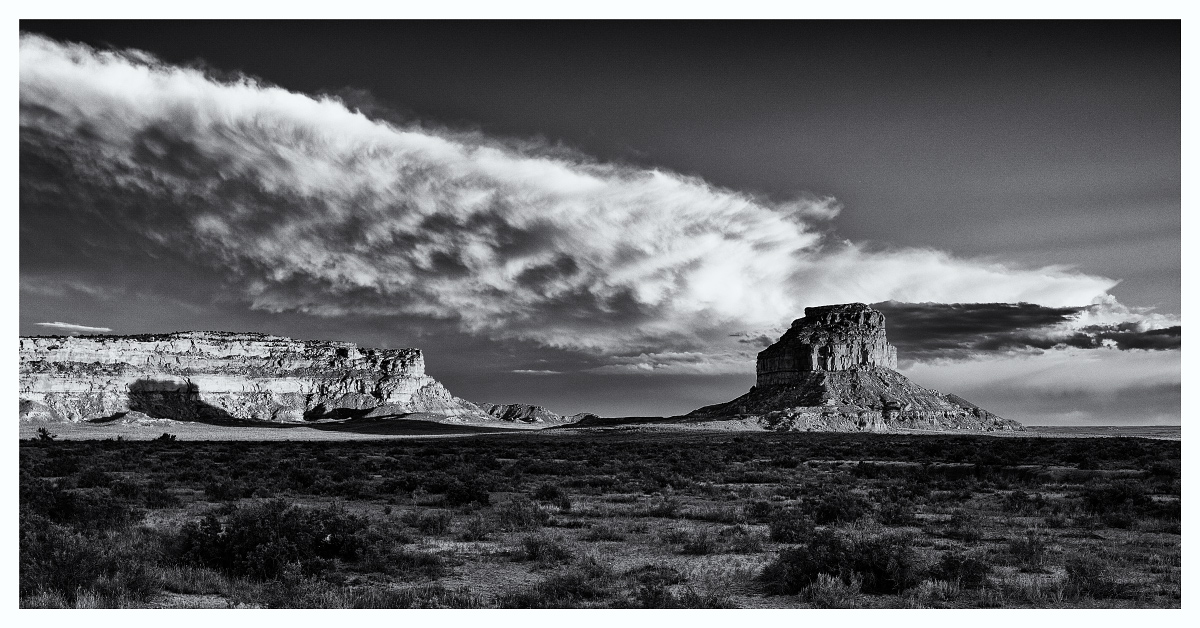
9-Aug-2013-2 by Colorado CJ, on Flickr
Later in the evening, we laid on the ground for a few hours, watching the night sky and catching about 30 meteors, a few being bright enough to leave vapor/smoke trails. Here's a shot I took during a lull in the meteor shower.
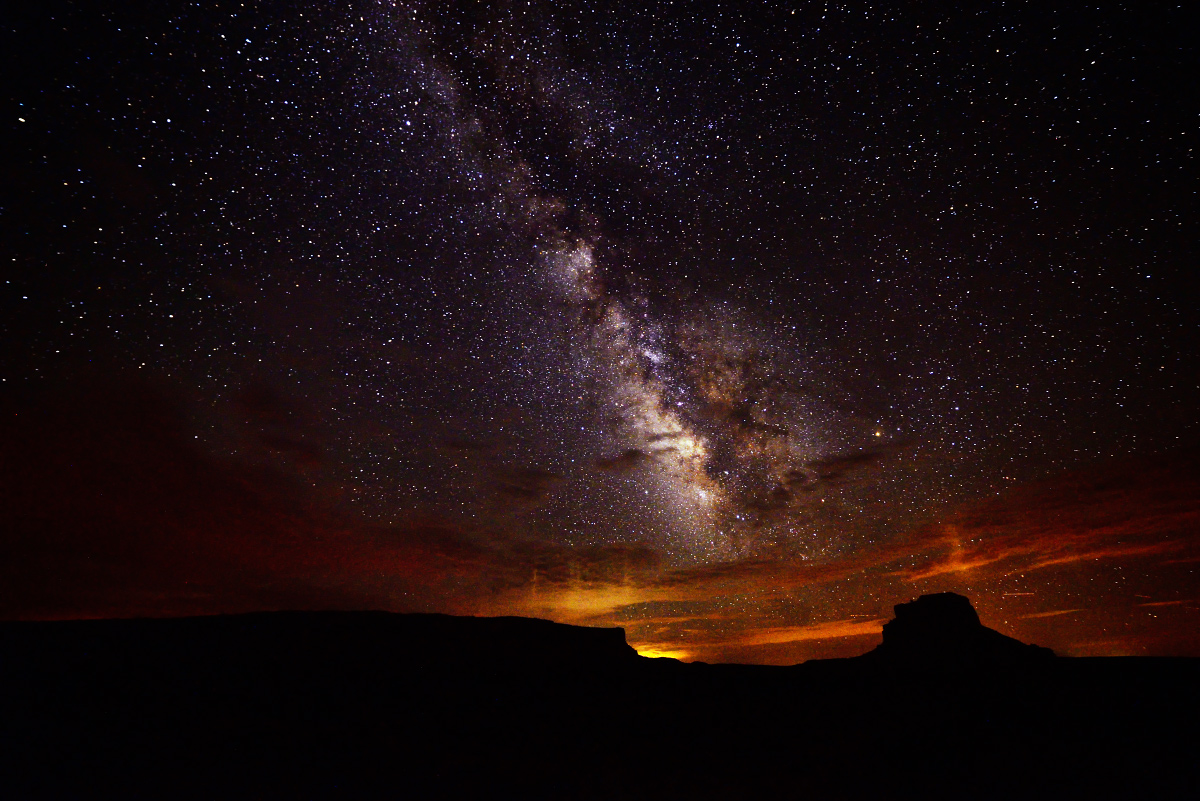
9-Aug-2013-1 by Colorado CJ, on Flickr
I'll be updating this post when I get more photos processed. |
|
| Back to top |
|
 |
RSalles


Joined: 12 Aug 2012
Posts: 1373
Location: Brazil - RS / South
|
 Posted: Wed Aug 14, 2013 12:57 am Post subject: Posted: Wed Aug 14, 2013 12:57 am Post subject: |
 |
|
RSalles wrote:
Well, I'm a lucky man 'cause I know already your style, it spared me a hearth attack with the first pic.
Simply beautiful, congrats, and do us a favor: keep shooting!
Cheers,
Renato |
|
| Back to top |
|
 |
NikonD


Joined: 29 Jul 2008
Posts: 1922
Location: Slovenija
|
 Posted: Wed Aug 14, 2013 9:23 pm Post subject: Posted: Wed Aug 14, 2013 9:23 pm Post subject: |
 |
|
NikonD wrote:
the second is f****** amazing! |
|
| Back to top |
|
 |
Colorado CJ

Joined: 29 Jul 2012
Posts: 210
Location: Northern Colorado
|
 Posted: Thu Aug 15, 2013 12:37 am Post subject: Posted: Thu Aug 15, 2013 12:37 am Post subject: |
 |
|
Colorado CJ wrote:
| RSalles wrote: |
Well, I'm a lucky man 'cause I know already your style, it spared me a hearth attack with the first pic.
Simply beautiful, congrats, and do us a favor: keep shooting!
Cheers,
Renato |
Glad you didn't have a hear attack 
Thank you for your comments. |
|
| Back to top |
|
 |
Colorado CJ

Joined: 29 Jul 2012
Posts: 210
Location: Northern Colorado
|
 Posted: Thu Aug 15, 2013 12:38 am Post subject: Posted: Thu Aug 15, 2013 12:38 am Post subject: |
 |
|
Colorado CJ wrote:
| NikonD wrote: |
| the second is f****** amazing! |
Thanks, glad you liked it! |
|
| Back to top |
|
 |
Colorado CJ

Joined: 29 Jul 2012
Posts: 210
Location: Northern Colorado
|
 Posted: Thu Aug 15, 2013 12:39 am Post subject: Posted: Thu Aug 15, 2013 12:39 am Post subject: |
 |
|
Colorado CJ wrote:
During the second day, we explored the different Great Houses in Chaco Canyon. These photos do NOT do them justice.
It is hard to believe these are 1000 year old ruins and hard to imagine the labor needed to form these individual stones, as well as cutting and hauling massive trees for hundreds of miles to this dry canyon, all by hand, and all by simple stone tools.
The back wall of Chetro Ketl

9-Aug-2013-3 by Colorado CJ, on Flickr
Pueblo Bonito is a HUGE structure that covers many acres. You can see where there were up to 4 story high rooms and massive kivas. There is a section that you can walk into and explore. It is awe inspiring to see it in person.
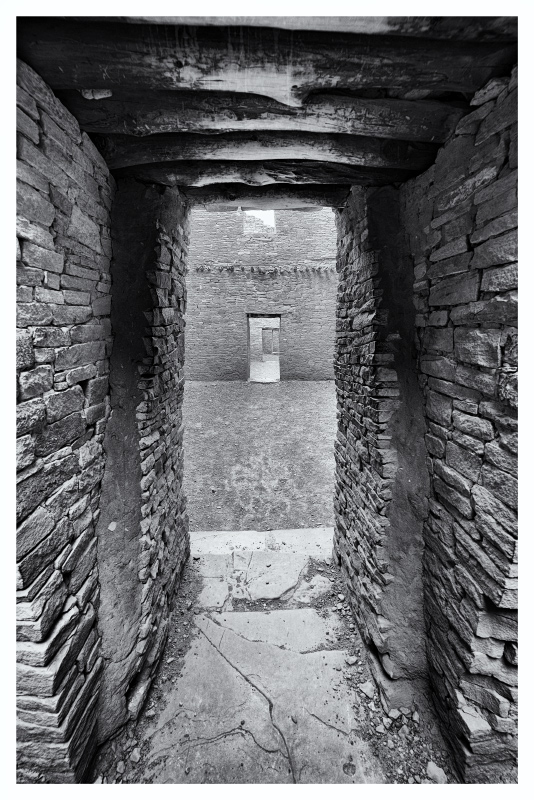
9-Aug-2013-4 by Colorado CJ, on Flickr
The black and white treatment didn't work for this one.
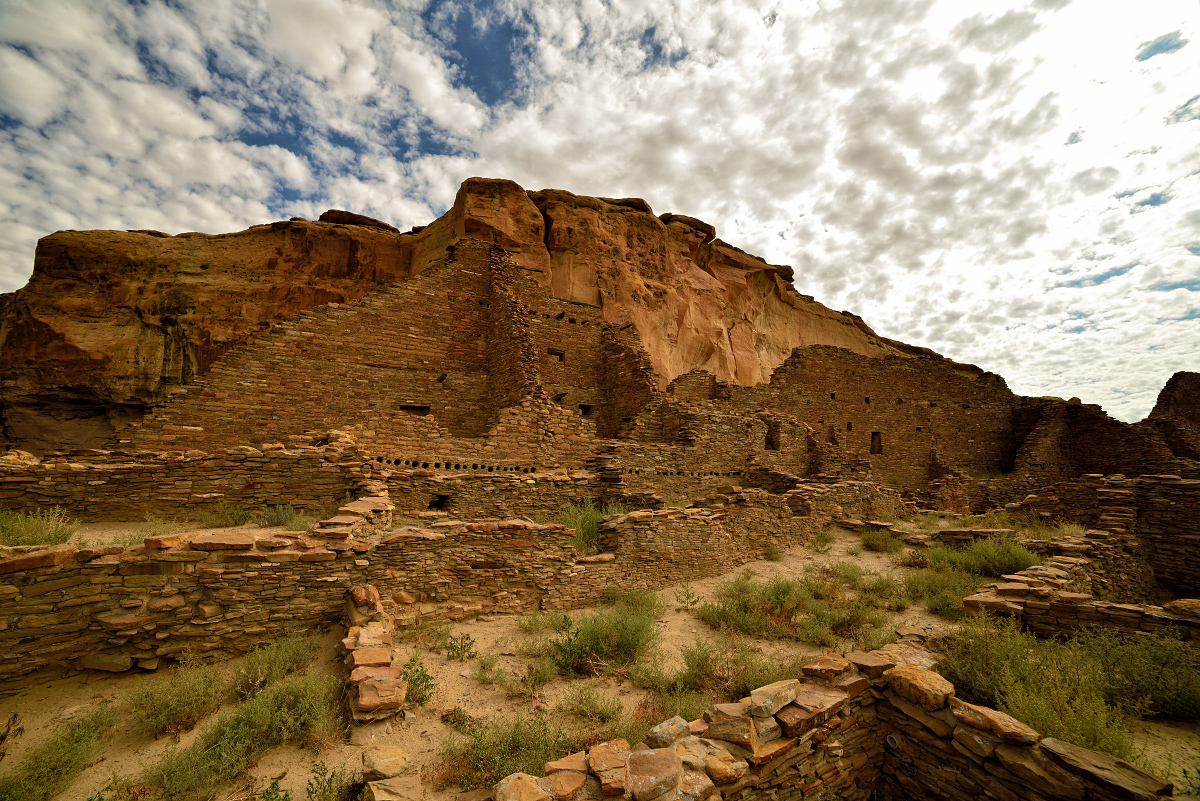
9-Aug-2013-5 by Colorado CJ, on Flickr
Pueblo Bonito once again.

Pueblo-Bonito-2----Chaco-Canyon by Colorado CJ, on Flickr
Here is one of the Great Kivas in Pueblo Bonito. These are huge structures. It is amazing to think that they had the technology to span this wide of a hole with a roof, all cut with stone tools. It must have really been something to see when they were in good shape.
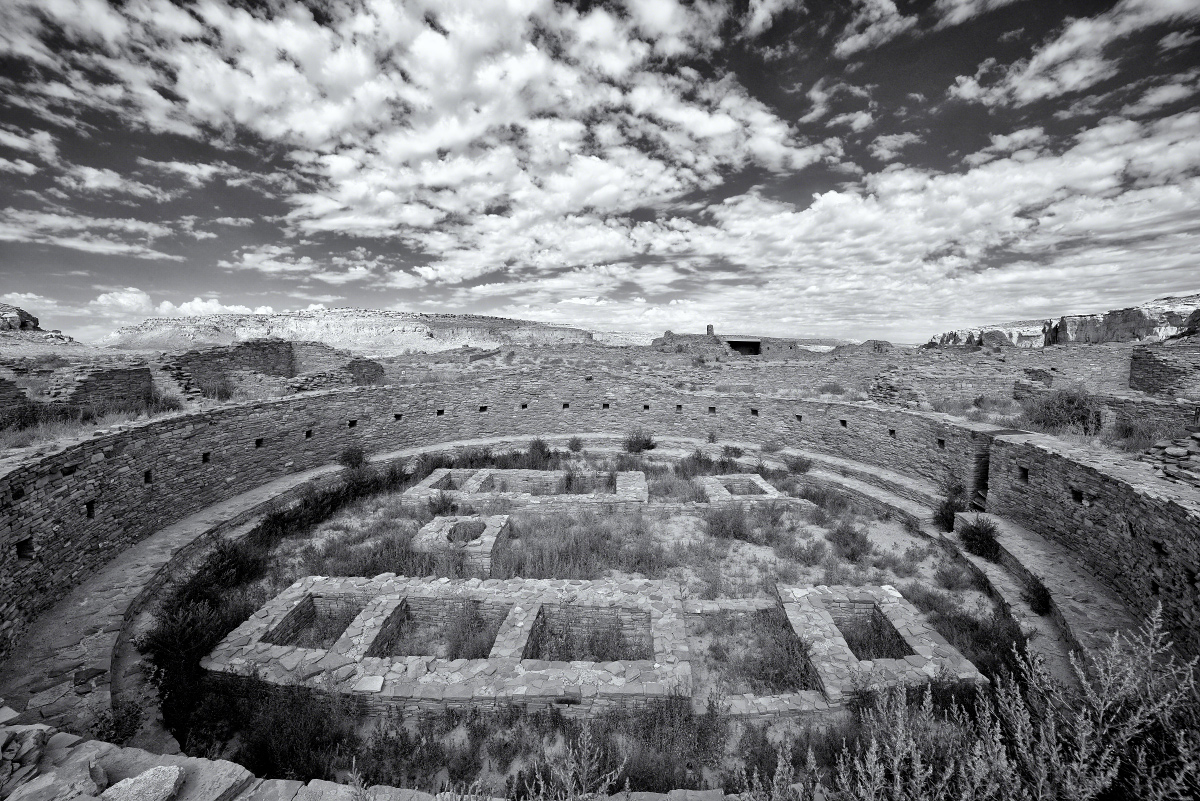
Great-Kiva----Chaco-Canyon by Colorado CJ, on Flickr
After walking though Chetro Ketl and Pueblo Bonito, we headed up the trail that goes to Pueblo Alto and New Alto. The trail climbs up a steep, narrow chimney in the side of the canyon.

Trail-to-Pueblo-Alto by Colorado CJ, on Flickr |
|
| Back to top |
|
 |
Colorado CJ

Joined: 29 Jul 2012
Posts: 210
Location: Northern Colorado
|
 Posted: Thu Aug 15, 2013 4:48 pm Post subject: Posted: Thu Aug 15, 2013 4:48 pm Post subject: |
 |
|
Colorado CJ wrote:
Pueblo Bonito from the canyon rim
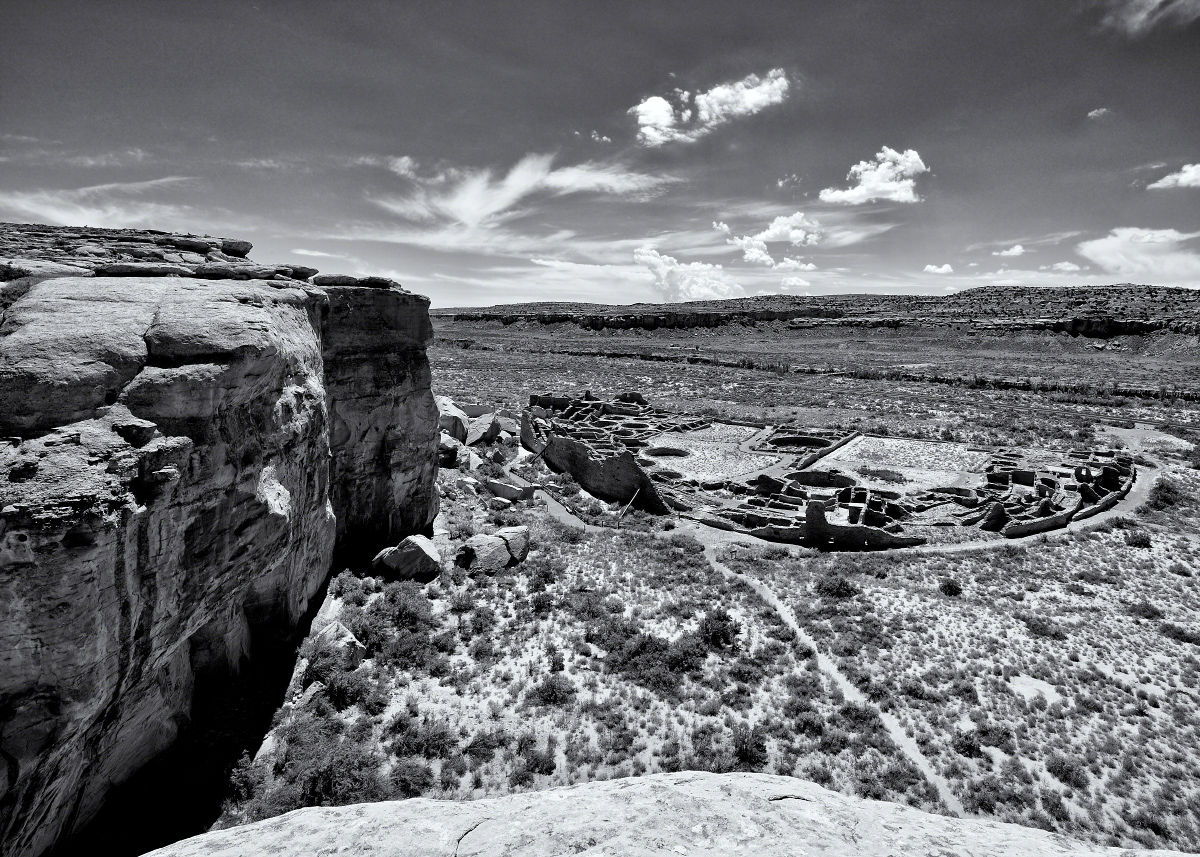
Pueblo-Bonito-3----Chaco-Canyon by Colorado CJ, on Flickr
Continuing up the trail to Pueblo Alto, you come across many smaller structures such as pecked out catch basins in the rim rock to catch water from the infrequent rains. There are also Chacoan steps still visible along the canyon walls and higher up.
Here are a few Chacoan Steps. You can see them in the bottom/center of the image.

Chacoan-Steps---Chaco-Canyon by Colorado CJ, on Flickr
There are many sites on top of the tableland outside of the canyon. Pueblo Alto is a huge structure that is mostly a mount of wind blown sand and overgrown with brush. A later, smaller pueblo, New Alto sits to the west a short distance.

New-Alto----Chaco-Canyon by Colorado CJ, on Flickr
This is just a shot of my brother and nephew walking down into the slot that takes you to the canyon floor.
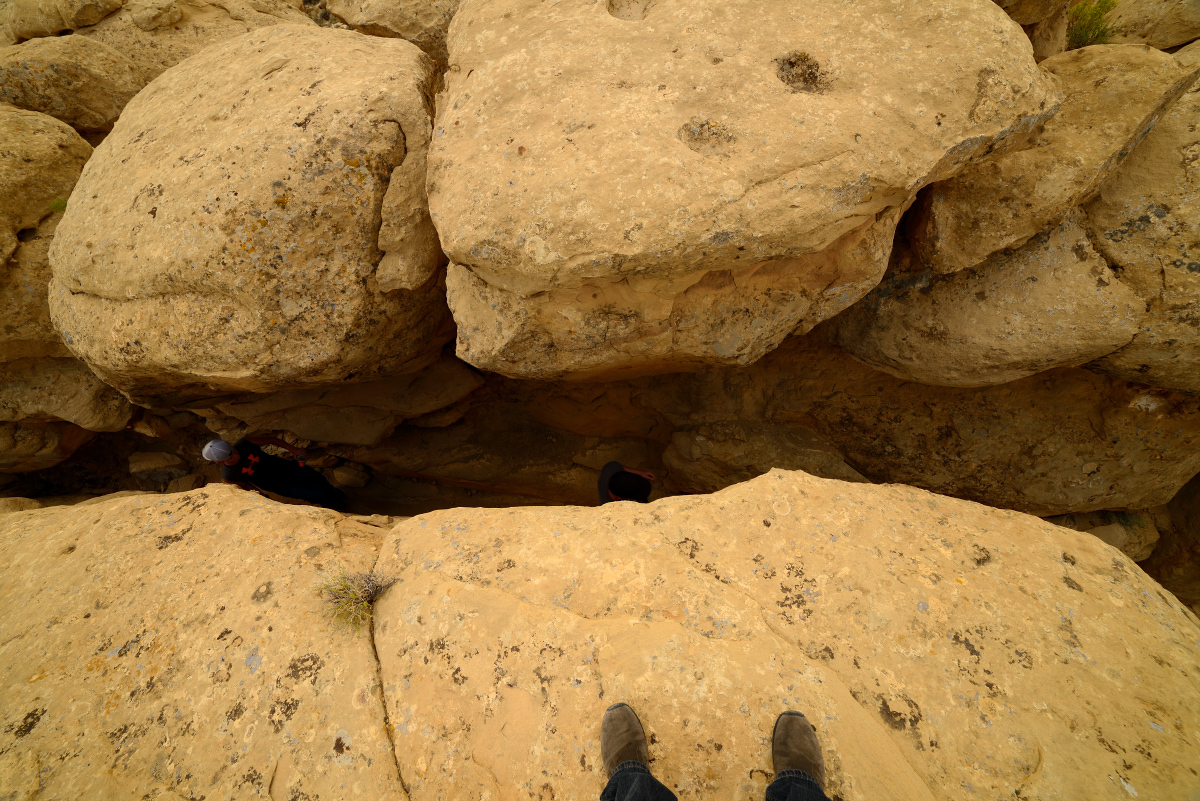
Pueblo-Alto-Trail by Colorado CJ, on Flickr
Coming out of the slot you have Kin Kletso in front of you.
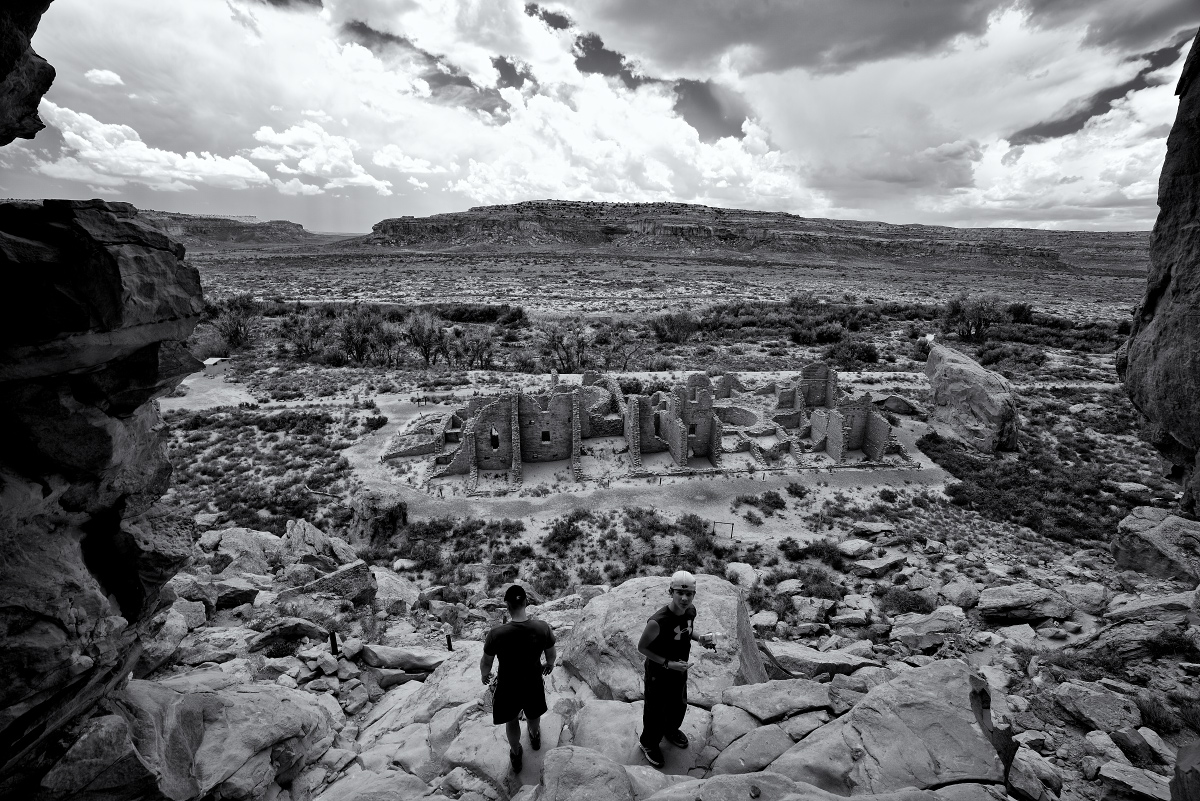
Kin-Kletso----Chaco-Canyon by Colorado CJ, on Flickr
Up Next -- Mesa Verde! |
|
| Back to top |
|
 |
RSalles


Joined: 12 Aug 2012
Posts: 1373
Location: Brazil - RS / South
|
 Posted: Fri Aug 16, 2013 12:34 am Post subject: Posted: Fri Aug 16, 2013 12:34 am Post subject: |
 |
|
RSalles wrote:
Fantastic place, and very photographic friendly. I suppose that Pueblo Bonito is what rests from an Mexican and maybe Mayan built village. The american indians were mostly "nomades", moving many times during the year for hunting and I'm not sure if they built villages like this one. If I'm wrong, please contribute to my education about the America's civilization history,
Cheers,
Renato |
|
| Back to top |
|
 |
l9magen

Joined: 13 Jul 2011
Posts: 326
Location: Calgary, Canada
Expire: 2016-10-21
|
 Posted: Fri Aug 16, 2013 4:56 am Post subject: Posted: Fri Aug 16, 2013 4:56 am Post subject: |
 |
|
l9magen wrote:
I think these are great shots -please keep them coming. I visited this area (not these ruins unfortunately) years ago, before I got into photography. Your shots are going to prompt a road trip. As I recall the light in the area, and how it changes through the day on the rocks of this area, many of the shots one sees are colour. But I really like the black&white approach. Did you shoot film or is it post-processed from digital?
.. great work.
_________________
Lochlann
Digital Camera: Leica MM246 & M10
RF lenses: Zeiss ZM, assorted Japanese LTMs & Nikkor-S |
|
| Back to top |
|
 |
mzzyhmd


Joined: 01 Jul 2013
Posts: 99
Location: Florida
|
 Posted: Fri Aug 16, 2013 9:34 pm Post subject: Posted: Fri Aug 16, 2013 9:34 pm Post subject: |
 |
|
mzzyhmd wrote:
uneffingbelieveable!!
amazing shots! what camera did you use care to share? did you stitch the photos?
_________________
Nex 6: Sony 16/2.8|| Vivitar Komine 24/2|| Sigma 30/2.8|| Rokinon 35/1.4|| Jupiter 8||Helios 53/1.8|| Minolta Rokkor PF 55/1.7|| CZJ Pancolar 50/1.8||Steinheil 85/2.8||Leica Elmar 90/4||Meyer Orestor 135/2.8||Tair 133/2.8 |
|
| Back to top |
|
 |
skida


Joined: 02 Mar 2012
Posts: 1826
Location: North East England
|
 Posted: Sat Aug 17, 2013 1:47 am Post subject: Posted: Sat Aug 17, 2013 1:47 am Post subject: |
 |
|
skida wrote:
Another fantastic trip and another set of fantastic photos!
_________________
Lots of 35mm Film Cameras
Lots of Lenses
New Vlog on Youtube called "The Olduns Shot"
https://www.youtube.com/channel/UCBHCOHaIrcYr7s3is1EcqxQ |
|
| Back to top |
|
 |
Colorado CJ

Joined: 29 Jul 2012
Posts: 210
Location: Northern Colorado
|
 Posted: Sat Aug 17, 2013 7:31 pm Post subject: Posted: Sat Aug 17, 2013 7:31 pm Post subject: |
 |
|
Colorado CJ wrote:
| RSalles wrote: |
Fantastic place, and very photographic friendly. I suppose that Pueblo Bonito is what rests from an Mexican and maybe Mayan built village. The american indians were mostly "nomades", moving many times during the year for hunting and I'm not sure if they built villages like this one. If I'm wrong, please contribute to my education about the America's civilization history,
Cheers,
Renato |
Thank you. These were actually built by the Anasazi (Ancestral Puebloan) indians. Over 1000 years, they graduated from simple pits, to pit houses, then to small houses and finally cliff dwellings and great houses. They were basket weavers, but once they started making pottery, they became less nomadic and started building these large structures. The modern day Hopi and Zuni tribes claim that the Anasazi were their ancestors.
In parts of the southwest, there are still pueblos being lived in today, along with the whole Kiva culture and belief in Kachinas. It is a VERY interesting area of study for me.
If you'd like, you can find a very well done documentary of Chaco Canyon. Here is a link to the documentary on line (there are popups on this site, but just close them and pick a stream): http://www.primewire.ag/watch-25980-The-Mystery-of-Chaco-Canyon
_________________
http://andrewmarjamaphotography.com |
|
| Back to top |
|
 |
Colorado CJ

Joined: 29 Jul 2012
Posts: 210
Location: Northern Colorado
|
 Posted: Sat Aug 17, 2013 7:35 pm Post subject: Posted: Sat Aug 17, 2013 7:35 pm Post subject: |
 |
|
Colorado CJ wrote:
| l9magen wrote: |
I think these are great shots -please keep them coming. I visited this area (not these ruins unfortunately) years ago, before I got into photography. Your shots are going to prompt a road trip. As I recall the light in the area, and how it changes through the day on the rocks of this area, many of the shots one sees are colour. But I really like the black&white approach. Did you shoot film or is it post-processed from digital?
.. great work. |
Thank you. These are being shot in color on my D600, processed to TIFF files, then converted to B&W using Nik Software Silver Efex (VERY good software).
_________________
http://andrewmarjamaphotography.com |
|
| Back to top |
|
 |
Colorado CJ

Joined: 29 Jul 2012
Posts: 210
Location: Northern Colorado
|
 Posted: Sat Aug 17, 2013 7:37 pm Post subject: Posted: Sat Aug 17, 2013 7:37 pm Post subject: |
 |
|
Colorado CJ wrote:
| mzzyhmd wrote: |
uneffingbelieveable!!
amazing shots! what camera did you use care to share? did you stitch the photos? |
Thank you. I am using a Nikon D600. These photos are all from single captures, no HDR or stitching. The first photo was taken with a Samyang 35mm f1.4 manual lens and the rest were taken with a Samyang 14mm F2.8 manual lens. Both EXCELLENT lenses and great value for your money.
_________________
http://andrewmarjamaphotography.com |
|
| Back to top |
|
 |
Colorado CJ

Joined: 29 Jul 2012
Posts: 210
Location: Northern Colorado
|
 Posted: Sat Aug 17, 2013 7:37 pm Post subject: Posted: Sat Aug 17, 2013 7:37 pm Post subject: |
 |
|
Colorado CJ wrote:
| skida wrote: |
| Another fantastic trip and another set of fantastic photos! |
Thank you. I wouldn't want to live anywhere else. These weekend trips wouldn't be possible if I lived further away.
_________________
http://andrewmarjamaphotography.com |
|
| Back to top |
|
 |
Colorado CJ

Joined: 29 Jul 2012
Posts: 210
Location: Northern Colorado
|
 Posted: Sat Aug 17, 2013 7:38 pm Post subject: Posted: Sat Aug 17, 2013 7:38 pm Post subject: |
 |
|
Colorado CJ wrote:
As we continue.... That evening and into the night the heavens opened up and it rained for a few hours. We had planned on staying at Chaco for the whole vacation, but my nephew has never been in the area and I wanted to show him just a little of Mesa Verde. So, the following morning, we packed camp and headed out. Because of the previous rain, there were a few muddy patches on the road that were slicker than snot. It made for a fun ~25 mile ride out of the park until we hit pavement. Good thing I had an all wheel drive car, even then we were a little sideways at times, it was FUN though, just glad we didn't get stuck.
Roughly 100 miles later, we arrive at Mesa Verde, in Southwest Colorado. This area is much different than Chaco. Instead of almost no people, Mesa Verde is PACKED with tourists from all over the world. Another difference is that Chaco is famous for its Great houses that are situated on open tableland, where Mesa Verde is famous for its Cliff Dwellings that tenuously cling to the side of cliffs, usually with a sheer vertical drop to the canyon floor. So, different construction techniques were used between the two as well as a completely different way of life for the Anasazi who lived here.
One other thing I liked about Chaco was that the whole place was open to explore at your leisure (you still need to stay on trails) I didn't see a park ranger anywhere during my visit. Mesa Verde, on the other hand, is a very structured environment with strict time tables and very little freedom to view the sites at your own pace. Many of the areas on top of the mesa are open to walk through without a guide, but just about every cliff dwelling has to be seen in a guided tour where the park ranger talks for 55 minutes and you only get one or two minutes at the end to take a few photos and look at the site. You are then ushered off to make room for the next group. Leaving little time to actually enjoy the site. Only a few of the thousands of sites are open to the public.
I understand why Mesa Verde has to be run like this though. There are so many people who visit on a daily basis that it really can't be run any other way. I MUCH prefer the "go at your own pace" experience you get at Chaco though.
Enough rambling, on to the photos!
The first cliff dwelling we visited is Balcony House. This is a pretty fun cliff dwelling tour to go on as you have to climb tall wood ladders, crawl through tunnels and climb up the cliff face while all you have to hold onto is a chain set in the stone. Probably my favorite of the bunch. It is a smaller cliff dwelling, but is very well preserved.
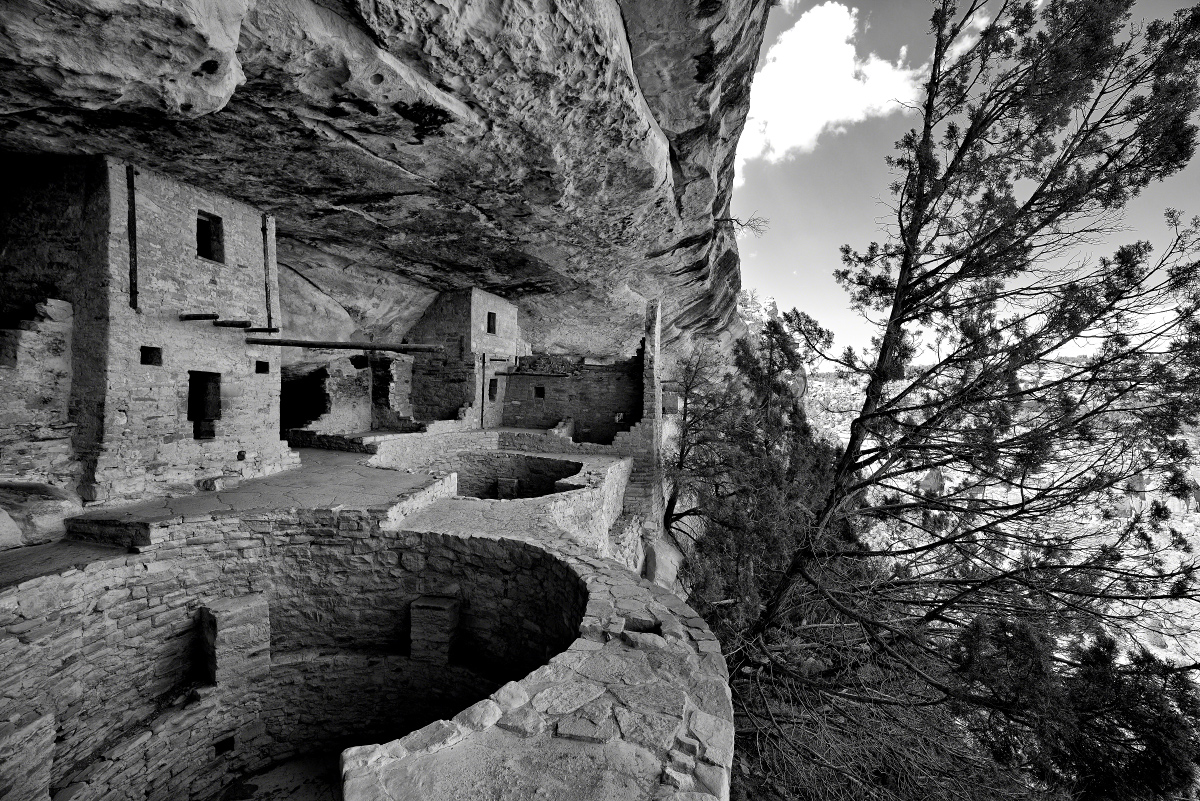
Balcony-House----Mesa-Verde by Colorado CJ, on Flickr
Balcony House was built with defense in mind. Here is the original entrance to the alcove where the cliff dwelling is located. There are two 8-foot SMALL tunnels with a central area to stand in. We are bigger guys (not fat wise) and have to go in sideways as our shoulders don't fit.
This was a defensive fortification built later in Balcony Houses occupation. It is theorized that someone was on guard in the central area of the tunnel, only letting those pass he recognized. All others had their heads caved in as they tried to crawl through.
My brother going into the tunnel

Balcony-House-Entrance-Tunnel----Mesa-Verde by Colorado CJ, on Flickr
Next up, Cliff Palace. This is the largest cliff dwelling in the park. You access the alcove by a number of stairs, some carved from the native rock.
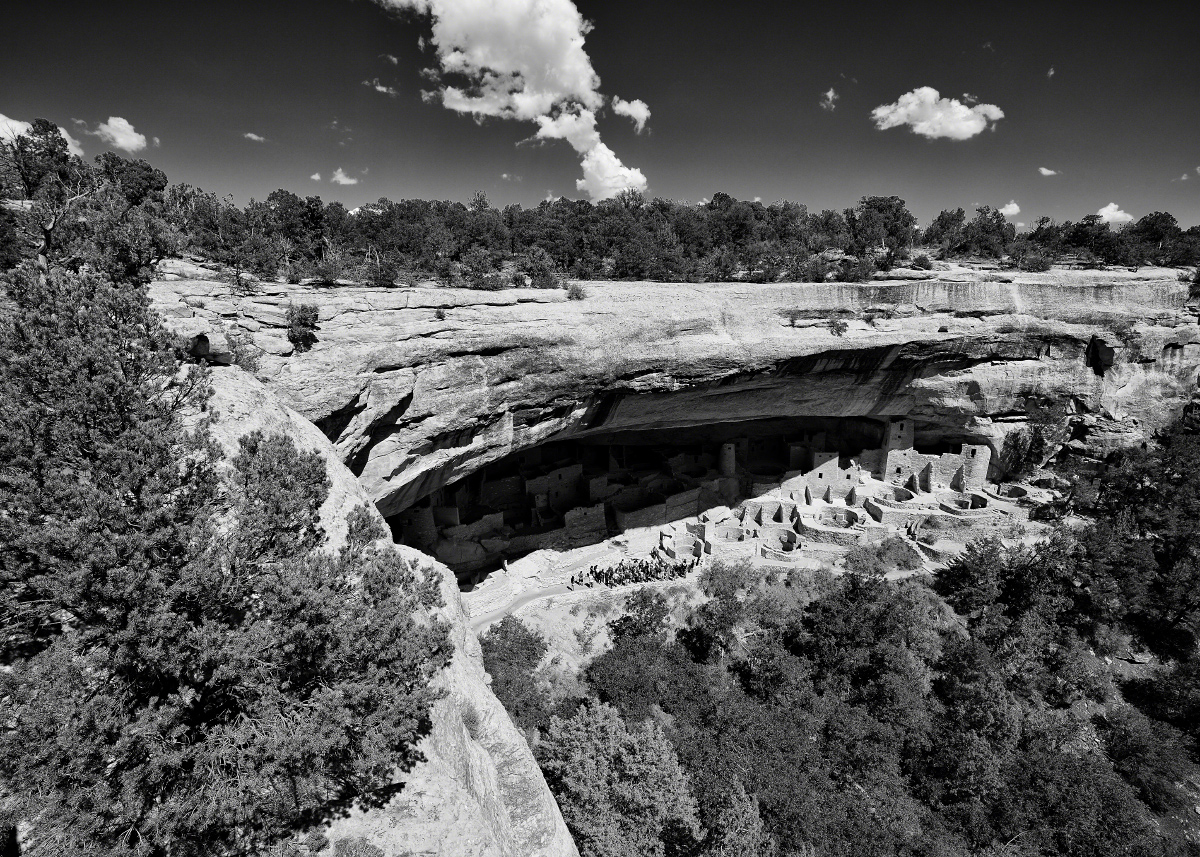
Cliff-Palace----Mesa-Verde by Colorado CJ, on Flickr
I REALLY wish I had more time here to take photos, without all the crowds getting in the way.
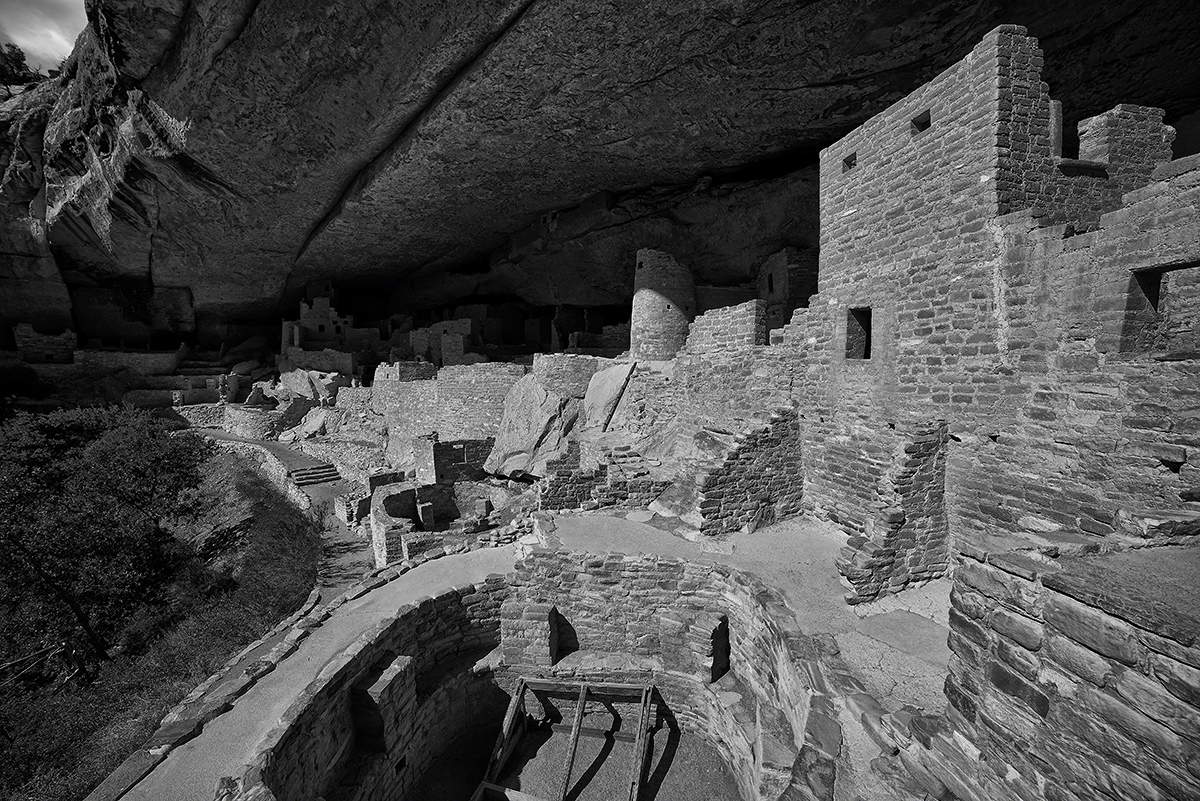
Cliff-Palace-2----Mesa-Verde by Colorado CJ, on Flickr
This is a shot taken from the entrance to a 4 story tower block. The original floors have crumbled, leaving some of the substructure behind. You can see on the third level how these structures were originally plastered. The plaster and decorative paint are untouched, original work from roughly 800 years ago.
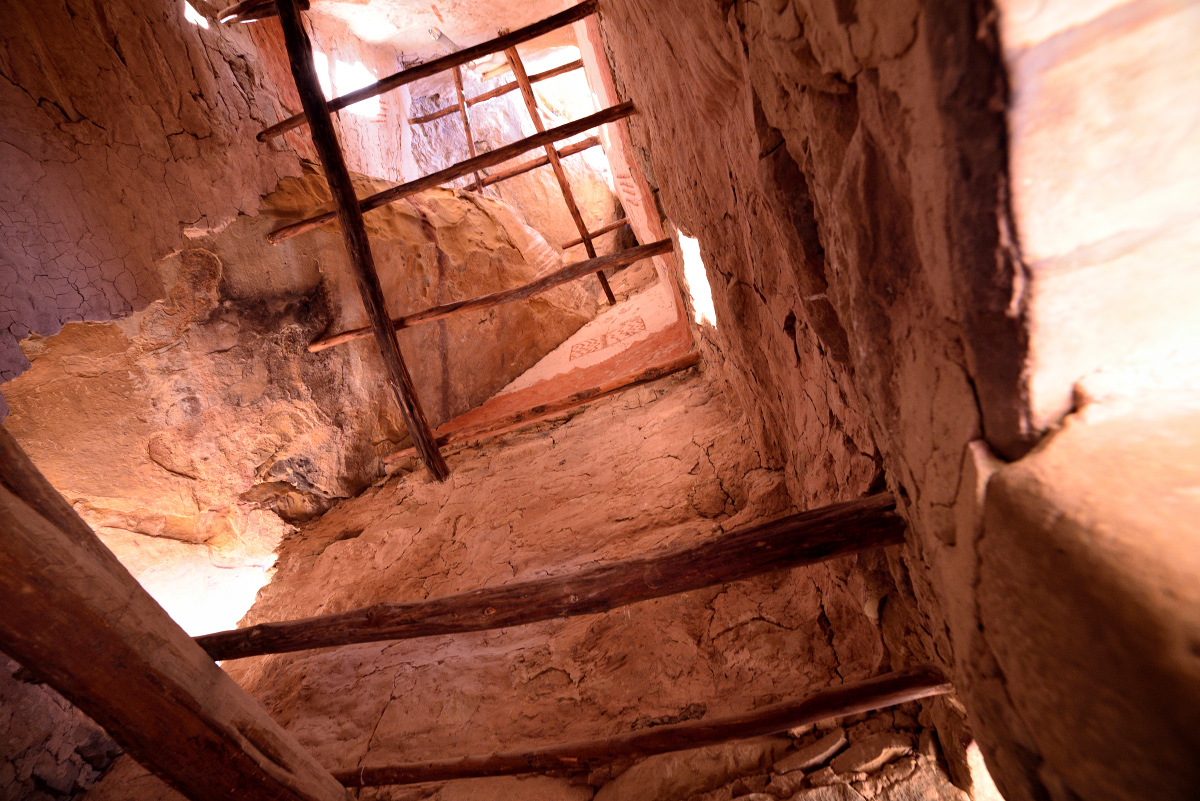
Tower-Cliff-Palace----Mesa-Verde by Colorado CJ, on Flickr
Up next, Spruce Tree House and Spruce Canyon
_________________
http://andrewmarjamaphotography.com |
|
| Back to top |
|
 |
poilu

Joined: 26 Aug 2007
Posts: 10471
Location: Greece
Expire: 2019-08-29
|
 Posted: Sat Aug 17, 2013 10:58 pm Post subject: Posted: Sat Aug 17, 2013 10:58 pm Post subject: |
 |
|
poilu wrote:
amazing series ! indeed no need to stitch with the 14mm
_________________
T* |
|
| Back to top |
|
 |
RSalles


Joined: 12 Aug 2012
Posts: 1373
Location: Brazil - RS / South
|
 Posted: Sun Aug 18, 2013 2:40 am Post subject: Posted: Sun Aug 18, 2013 2:40 am Post subject: |
 |
|
RSalles wrote:
| Colorado CJ wrote: |
| RSalles wrote: |
Fantastic place, and very photographic friendly. I suppose that Pueblo Bonito is what rests from an Mexican and maybe Mayan built village. The american indians were mostly "nomades", moving many times during the year for hunting and I'm not sure if they built villages like this one. If I'm wrong, please contribute to my education about the America's civilization history,
Cheers,
Renato |
Thank you. These were actually built by the Anasazi (Ancestral Puebloan) indians. Over 1000 years, they graduated from simple pits, to pit houses, then to small houses and finally cliff dwellings and great houses. They were basket weavers, but once they started making pottery, they became less nomadic and started building these large structures. The modern day Hopi and Zuni tribes claim that the Anasazi were their ancestors.
In parts of the southwest, there are still pueblos being lived in today, along with the whole Kiva culture and belief in Kachinas. It is a VERY interesting area of study for me.
If you'd like, you can find a very well done documentary of Chaco Canyon. Here is a link to the documentary on line (there are popups on this site, but just close them and pick a stream): http://www.primewire.ag/watch-25980-The-Mystery-of-Chaco-Canyon |
Thank you, great trip indeed!
I have a great interest also for the pre-colombian civilizations, in America - south, center and north, and this interest was born at the years when I lived in Bolivia - the family has to leave Brazil for some years for political reasons at the '60 and '70 years. At 20 I made some trips at the BOL-Peru border, and Peru, at Machu-Pichu, Cuzco, Nazca et all.
Thanks for the video link, I'll jet an eye for sure, ASAP,
Cheers,
Renato |
|
| Back to top |
|
 |
pich900


Joined: 10 Jun 2007
Posts: 1745
Location: The Netherlands/Zwolle
Expire: 2012-12-27
|
 Posted: Mon Aug 19, 2013 9:31 am Post subject: Posted: Mon Aug 19, 2013 9:31 am Post subject: |
 |
|
pich900 wrote:
This is quite an amazing serie but the second image (first page) is simply heartbreaking  ....How long was the exposure on this one??? ....How long was the exposure on this one???
And such an amazing place as well....
_________________
All my lenses are for sale, nikkor, Angenieux, Zeiss etc.....
Regards,
Pascal
-------------------------------------------------------
Nikon D700 |
|
| Back to top |
|
 |
Colorado CJ

Joined: 29 Jul 2012
Posts: 210
Location: Northern Colorado
|
 Posted: Tue Aug 20, 2013 2:14 am Post subject: Posted: Tue Aug 20, 2013 2:14 am Post subject: |
 |
|
Colorado CJ wrote:
| RSalles wrote: |
Thank you, great trip indeed!
I have a great interest also for the pre-colombian civilizations, in America - south, center and north, and this interest was born at the years when I lived in Bolivia - the family has to leave Brazil for some years for political reasons at the '60 and '70 years. At 20 I made some trips at the BOL-Peru border, and Peru, at Machu-Pichu, Cuzco, Nazca et all.
Thanks for the video link, I'll jet an eye for sure, ASAP,
Cheers,
Renato |
That is one area of the world I'd love to visit. The whole pre columbian era of the Americas has always interested me too. Just takes time and money, both of which I seem to always be short of. Hopefully some day!
_________________
http://andrewmarjamaphotography.com |
|
| Back to top |
|
 |
Colorado CJ

Joined: 29 Jul 2012
Posts: 210
Location: Northern Colorado
|
 Posted: Tue Aug 20, 2013 2:15 am Post subject: Posted: Tue Aug 20, 2013 2:15 am Post subject: |
 |
|
Colorado CJ wrote:
| pich900 wrote: |
This is quite an amazing serie but the second image (first page) is simply heartbreaking  ....How long was the exposure on this one??? ....How long was the exposure on this one???
And such an amazing place as well.... |
Thank you, glad you are enjoying it!
The second photo was taken at ISO 6400, f4 and 25 sec exposure. I then post processed using Capture NX2.
_________________
http://andrewmarjamaphotography.com |
|
| Back to top |
|
 |
Colorado CJ

Joined: 29 Jul 2012
Posts: 210
Location: Northern Colorado
|
 Posted: Tue Aug 20, 2013 2:15 am Post subject: Posted: Tue Aug 20, 2013 2:15 am Post subject: |
 |
|
Colorado CJ wrote:
Time for the last few photos.
Later that day we went through the museum. The museum is filled with pottery, jewelry, stone tools, sandals and bits of woven cloth on display. It is a great place to spend some time in and sit in awe of what these people could accomplish with very rudimentary tools, especially the fine woven cloth.
Below the museum is Spruce canyon, in which Spruce Tree House sits. This is the one cliff dwelling that is open to everyone, no tours needed for this site. The downside to that is it is always crowded and it is hard to get photos without people in them.
Spruce Tree House sits in a very large, deep alcove. There are springs at the beginning of the canyon and a small stream runs down the center. It is almost a tropical environment with large trees and a lot of ground vegetation. The temperature in the cayon bottom is at least 20 degrees cooler than up on the mesa, I can see why they built here (I'd love to have a house there as well).
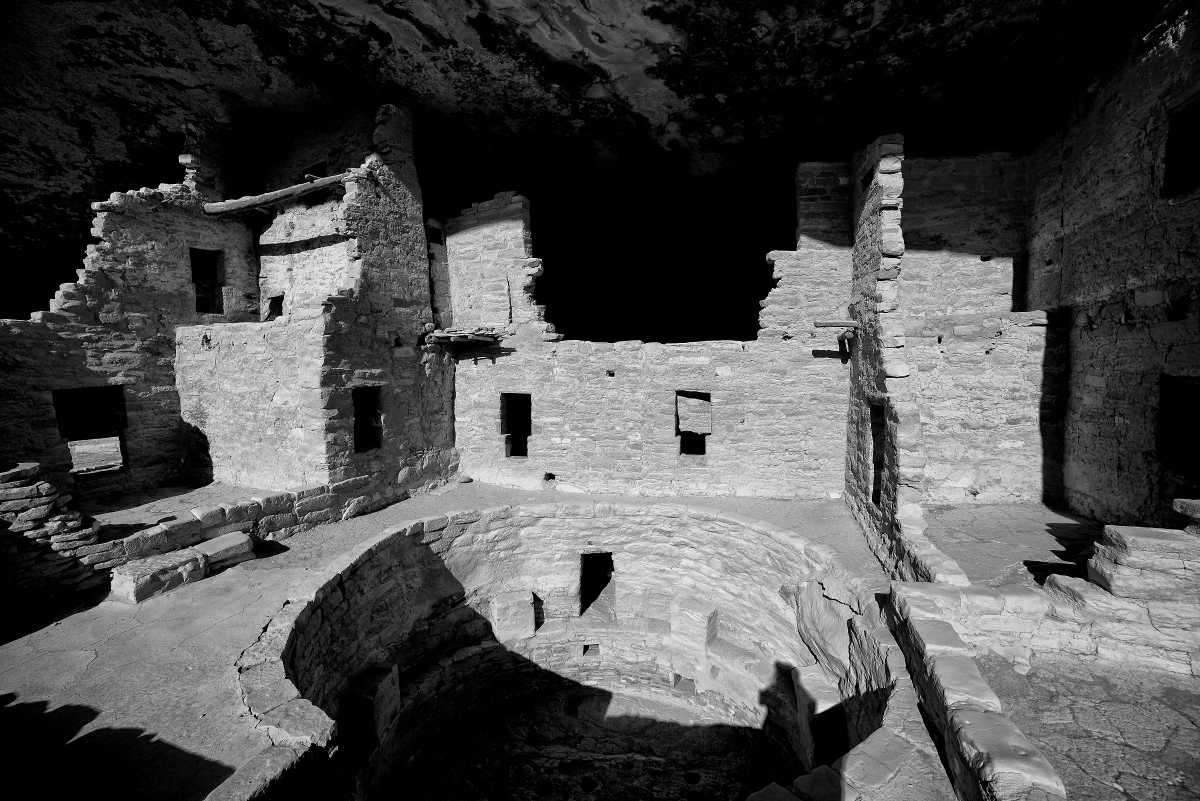
Spruce-Tree-House-2 by Colorado CJ, on Flickr

Spruce-Tree-House by Colorado CJ, on Flickr
As I said, the alcove that Spruce Tree House sits in is very deep. There are alleyways and buildings going all the way back into the alcove. This must have really been neat looking when it was being occupied, fires lighting the alleys between buildings.
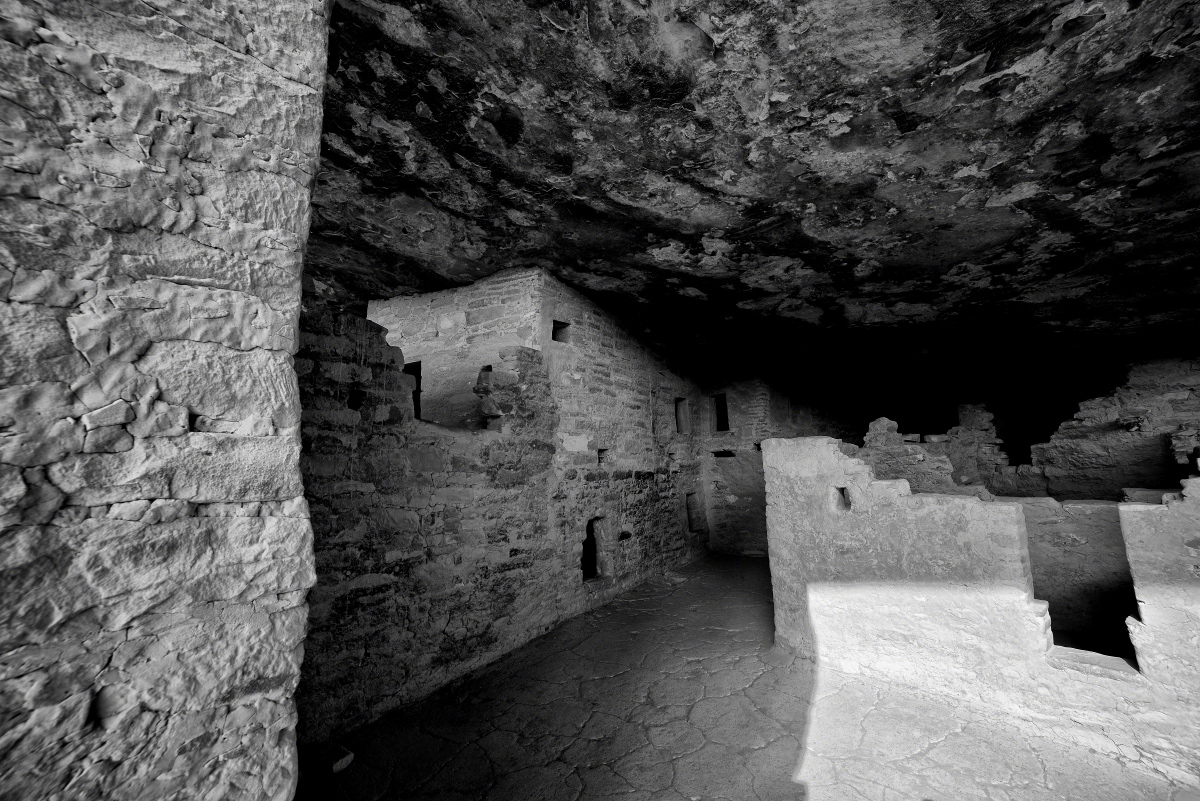
Spruce-Tree-House-3 by Colorado CJ, on Flickr
There is one reconstructed kiva at Spruce Tree House. It is interesting to go down into and see how they once made the roof structure. For some reason the fire pit and sipapu is not present in this kiva, probably to prevent the tourists from tripping.
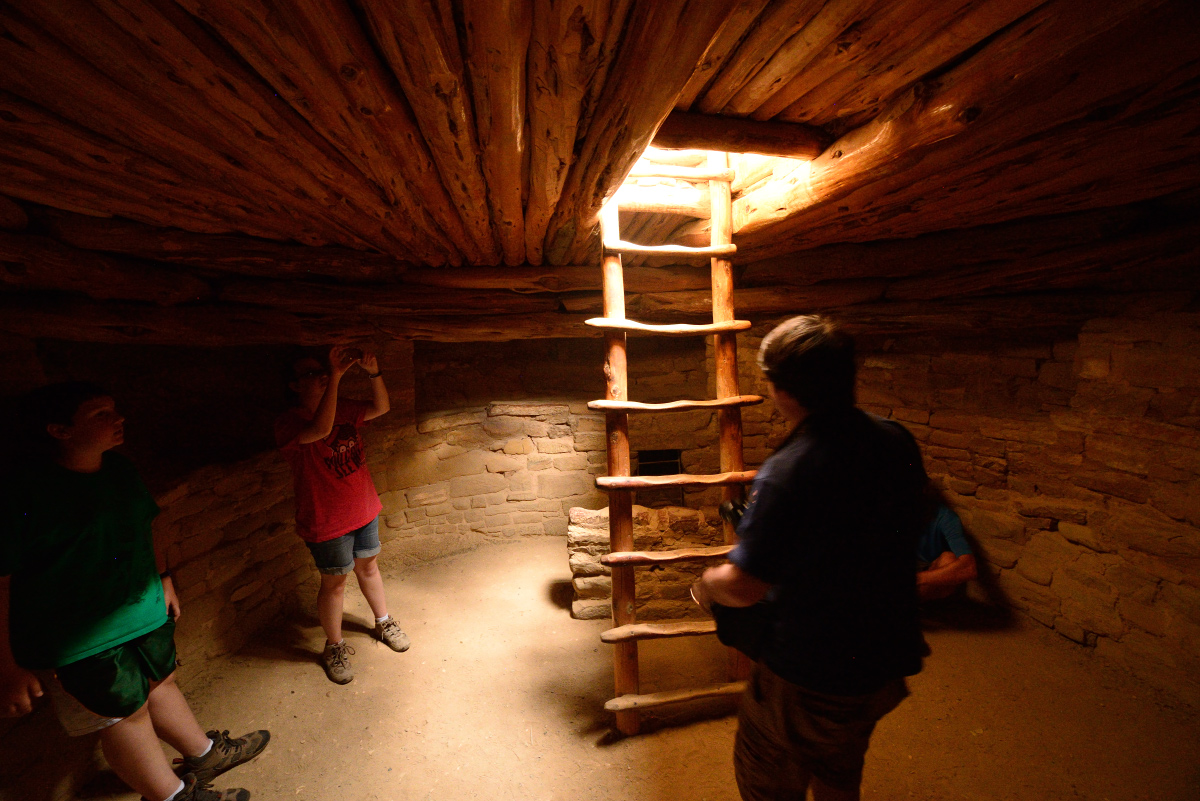
Kiva-at-Spruce-Tree-House by Colorado CJ, on Flickr
After visiting Spruce Tree House for a while, my brother, nephew and I headed down the trail that takes you to the bottom of the canyon. It is a nice hike, and has a good view of the canyons.
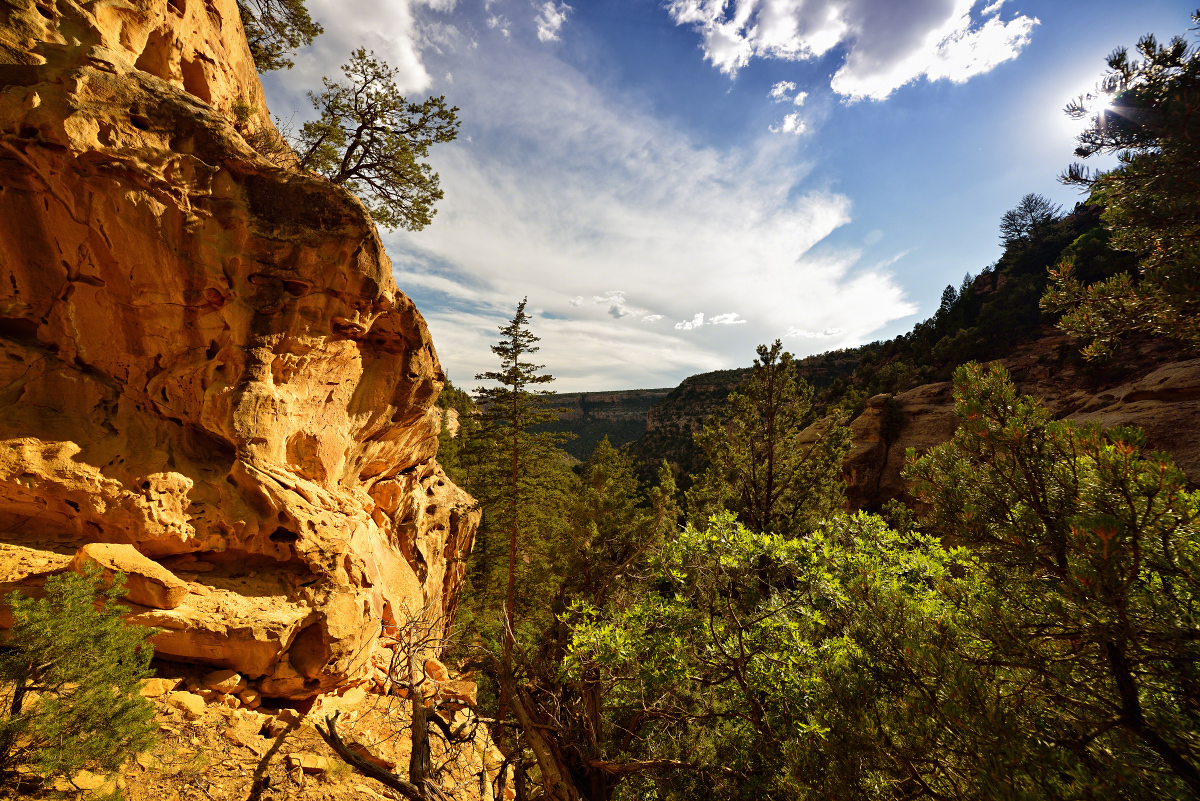
Spruce-Canyon----Mesa-Verde by Colorado CJ, on Flickr
That evening we laid in our bedrolls and watched the stars and fell asleep. I awoke in the early morning with a coyote yipping just a few feet away. He moved off after a few sniffs in the wind and I fell back asleep.
Well that's the end of the trip. I am hoping to get back out to the four corners this fall. Instead of exploring the ruins inside of parks though, I am planning on heading out to Cedar Mesa and Comb Ridge to hike into some of the lesser known areas where these cliff dwellings are very numerous and almost untouched since the Anasazi abandoned them 1000 years ago.
_________________
http://andrewmarjamaphotography.com |
|
| Back to top |
|
 |
kds315*


Joined: 12 Mar 2008
Posts: 16539
Location: Weinheim, Germany
Expire: 2021-03-09
|
 Posted: Tue Aug 20, 2013 6:14 am Post subject: Posted: Tue Aug 20, 2013 6:14 am Post subject: |
 |
|
kds315* wrote:
Great photos of an even greater landscape!
_________________
Klaus - Admin
"S'il vient a point, me souviendra" [Thomas Bohier (1460-1523)]
http://www.macrolenses.de for macro and special lens info
http://www.pbase.com/kds315/uv_photos for UV Images and lens/filter info
https://www.flickr.com/photos/kds315/albums my albums using various lenses
http://photographyoftheinvisibleworld.blogspot.com/ my UV BLOG
http://www.travelmeetsfood.com/blog Food + Travel BLOG
https://galeriafotografia.com Architecture + Drone photography
Currently most FAV lens(es):
X80QF f3.2/80mm
Hypergon f11/26mm
ELCAN UV f5.6/52mm
Zeiss UV-Planar f4/60mm
Zeiss UV-Planar f2/62mm
Lomo Уфар-12 f2.5/41mm
Lomo Зуфар-2 f4.0/350mm
Lomo ZIKAR-1A f1.2/100mm
Nikon UV Nikkor f4.5/105mm
Zeiss UV-Sonnar f4.3/105mm
CERCO UV-VIS-NIR f1.8/45mm
CERCO UV-VIS-NIR f4.1/94mm
CERCO UV-VIS-NIR f2.8/100mm
Steinheil Quarzobjektiv f1.8/50mm
Pentax Quartz Takumar f3.5/85mm
Carl Zeiss Jena UV-Objektiv f4/60mm
NYE OPTICAL Lyman-Alpha II f1.1/90mm
NYE OPTICAL Lyman-Alpha I f2.8/200mm
COASTAL OPTICS f4/60mm UV-VIS-IR Apo
COASTAL OPTICS f4.5/105mm UV-Micro-Apo
Pentax Ultra-Achromatic Takumar f4.5/85mm
Pentax Ultra-Achromatic Takumar f5.6/300mm
Rodenstock UV-Rodagon f5.6/60mm + 105mm + 150mm
|
|
| Back to top |
|
 |
|
|
